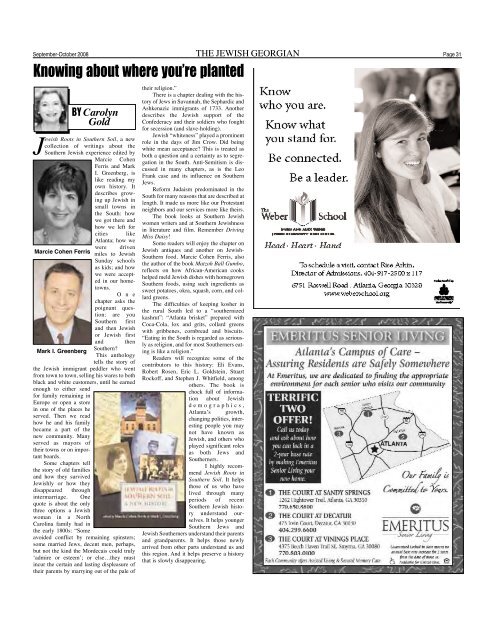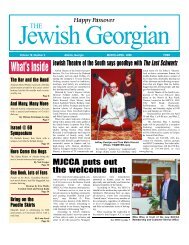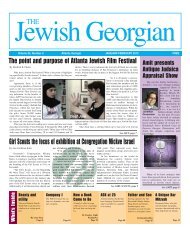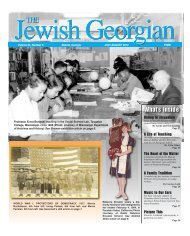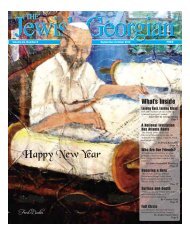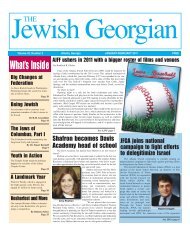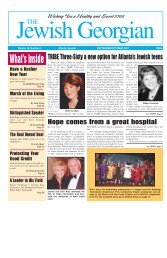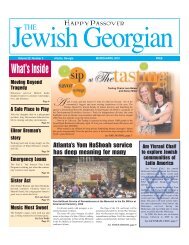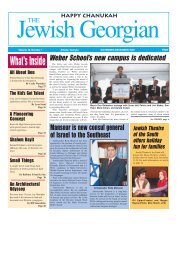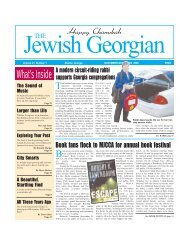You also want an ePaper? Increase the reach of your titles
YUMPU automatically turns print PDFs into web optimized ePapers that Google loves.
September-October 20<strong>08</strong> THE JEWISH GEORGIAN Page 31<br />
Knowing about where you’re planted<br />
J<br />
BY Carolyn<br />
Gold<br />
ewish Roots in Southern Soil, a new<br />
collection of writings about the<br />
Southern <strong>Jewish</strong> experience edited by<br />
Marcie Cohen<br />
Ferris and Mark<br />
I. Greenberg, is<br />
like reading my<br />
own history. It<br />
describes growing<br />
up <strong>Jewish</strong> in<br />
small towns in<br />
the South: how<br />
we got there and<br />
how we left for<br />
cities like<br />
Atlanta; how we<br />
were driven<br />
Marcie Cohen Ferris miles to <strong>Jewish</strong><br />
Sunday schools<br />
as kids; and how<br />
we were accepted<br />
in our hometowns.<br />
O n e<br />
chapter asks the<br />
poignant question:<br />
are you<br />
Southern first<br />
and then <strong>Jewish</strong><br />
or <strong>Jewish</strong> first<br />
and then<br />
Mark I. Greenberg<br />
Southern?<br />
This anthology<br />
tells the story of<br />
the <strong>Jewish</strong> immigrant peddler who went<br />
from town to town, selling his wares to both<br />
black and white customers, until he earned<br />
enough to either send<br />
for family remaining in<br />
Europe or open a store<br />
in one of the places he<br />
served. <strong>The</strong>n we read<br />
how he and his family<br />
became a part of the<br />
new community. Many<br />
served as mayors of<br />
their towns or on important<br />
boards.<br />
Some chapters tell<br />
the story of old families<br />
and how they survived<br />
<strong>Jewish</strong>ly or how they<br />
disappeared through<br />
intermarriage. One<br />
quote is about the only<br />
three options a <strong>Jewish</strong><br />
woman in a North<br />
Carolina family had in<br />
the early 1800s: “Some<br />
avoided conflict by remaining spinsters;<br />
some married Jews, decent men, perhaps,<br />
but not the kind the Mordecais could truly<br />
‘admire or esteem’; or else…they must<br />
incur the certain and lasting displeasure of<br />
their parents by marrying out of the pale of<br />
their religion.”<br />
<strong>The</strong>re is a chapter dealing with the history<br />
of Jews in Savannah, the Sephardic and<br />
Ashkenazic immigrants of 1733. Another<br />
describes the <strong>Jewish</strong> support of the<br />
Confederacy and their soldiers who fought<br />
for secession (and slave-holding).<br />
<strong>Jewish</strong> “whiteness” played a prominent<br />
role in the days of Jim Crow. Did being<br />
white mean acceptance? This is treated as<br />
both a question and a certainty as to segregation<br />
in the South. Anti-Semitism is discussed<br />
in many chapters, as is the Leo<br />
Frank case and its influence on Southern<br />
Jews.<br />
Reform Judaism predominated in the<br />
South for many reasons that are described at<br />
length. It made us more like our Protestant<br />
neighbors and our services more like theirs.<br />
<strong>The</strong> book looks at Southern <strong>Jewish</strong><br />
women writers and at Southern <strong>Jewish</strong>ness<br />
in literature and film. Remember Driving<br />
Miss Daisy!<br />
Some readers will enjoy the chapter on<br />
<strong>Jewish</strong> antiques and another on <strong>Jewish</strong>-<br />
Southern food. Marcie Cohen Ferris, also<br />
the author of the book Matzoh Ball Gumbo,<br />
reflects on how African-American cooks<br />
helped meld <strong>Jewish</strong> dishes with homegrown<br />
Southern foods, using such ingredients as<br />
sweet potatoes, okra, squash, corn, and collard<br />
greens.<br />
<strong>The</strong> difficulties of keeping kosher in<br />
the rural South led to a “southernized<br />
kashrut”: “Atlanta brisket” prepared with<br />
Coca-Cola, lox and grits, collard greens<br />
with gribbenes, cornbread and biscuits.<br />
“Eating in the South is regarded as seriously<br />
as religion, and for most Southerners eating<br />
is like a religion.”<br />
Readers will recognize some of the<br />
contributors to this history: Eli Evans,<br />
Robert Rosen, Eric L. Goldstein, Stuart<br />
Rockoff, and Stephen J. Whitfield, among<br />
others. <strong>The</strong> book is<br />
chock full of information<br />
about <strong>Jewish</strong><br />
demographics,<br />
Atlanta’s growth,<br />
changing politics, interesting<br />
people you may<br />
not have known as<br />
<strong>Jewish</strong>, and others who<br />
played significant roles<br />
as both Jews and<br />
Southerners.<br />
I highly recommend<br />
<strong>Jewish</strong> Roots in<br />
Southern Soil. It helps<br />
those of us who have<br />
lived through many<br />
periods of recent<br />
Southern <strong>Jewish</strong> history<br />
understand ourselves.<br />
It helps younger<br />
Southern Jews and<br />
<strong>Jewish</strong> Southerners understand their parents<br />
and grandparents. It helps those newly<br />
arrived from other parts understand us and<br />
this region. And it helps preserve a history<br />
that is slowly disappearing.


